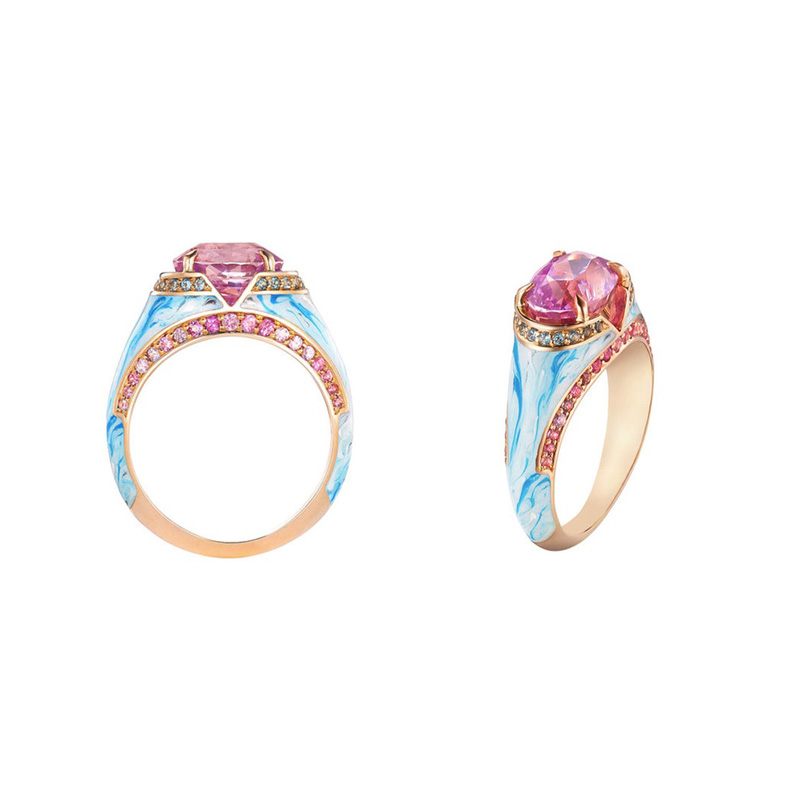It’s no coincidence that designer Alice Cicolini has made a name for herself during an era when jewellery is increasingly purchased by women themselves, no longer the preserve of the gift-buying boyfriend or husband.
Easy wins like diamond studs and tennis bracelets are not for her; in fact, diamonds rarely make an appearance at all. Instead her work is a soulful riot of colour, craftsmanship and decorative references inspired by everything from ancient Indian palaces to the Memphis design movement of the ’80s, from mid-century puppets to Jacobean architecture. “Our female customer loves eclectic design and colour, and Alice is the queen of both,” says Ruby Beales, jewellery buyer at Liberty London, which stocks her work.

For Sari, Cicolini’s latest collection, she turns once again to her beloved India for inspiration. She spent five years there as the British Council’s director of arts and culture before returning to London to study jewellery design at Central Saint Martins, and the collection is inspired by the countless styles and motifs of the traditional garment worn by women across the Indian subcontinent. “I was an avid wearer of saris at the time and loved how much variety there was in every region,” she says. “I think of them as textile jewels with all their embroidery, colour and gold thread. Everything about them highlights a woman’s body.”

She was helped in her research by Rta Kapur Chishti, a textile scholar and impresario in India, who spent many years travelling across the continent to document different traditions in terms of patterns, fabric weaving and wearing styles. A sari might reflect the flora and fauna of a particular region. The birds decorating a favourite sari of Cicolini’s from the eastern state of Odisha translate in the collection as a tiny creature perching on the crest of a hoop embellished with brightly hued sapphires to reflect the richness of Indian fabric dyes.

A ring centring on a juicy mandarin garnet is decorated with granulation: tiny gold beads that mimic the nubby textures of sari fabrics that might change from village to village, and which stand out against the blackness of the enamel surround.

Other regional sari traditions are more lyrical. In Rajasthan, for example, women wear a striped sari all the way through the monsoon season. “The rain eventually bleeds all the colours together and you’ve got a pink sari at the end. It’s like poetry,” Cicolini smiles. When a bride buys her wedding trousseau, she might choose fabric that reflects the place where she was born, or where she is moving to with her husband-to-be. “You’re making symbolic choices about what you wear. It’s more enigmatic than our mode of dressing, a bit like choosing a piece of jewellery to buy,” adds the designer.

The collection also gave Cicolini the chance to get creative with her signature enamel techniques. Enamel jewellery is ubiquitous these days, but it was she who helped bring it back to the fore with her first collections a decade ago, inspired as she was by the traditional Indian enamel technique of meenakari. This new collection was created entirely in the UK, and Cicolini worked closely with her craftspeople to keep innovating with this famously temperamental technique that fuses powdered glass and metal to vivid effect. One ring that centres on a hot pink sapphire is surrounded by a swirl of white and blue enamel, a marbling technique that was devilishly hard to pull off. “It’s only possible to keep pushing the boundaries of enamel because of the people I work with,” she says. “It’s so fulfilling to work with someone with 50 years’ experience in their field.”

Beales says Cicolini’s dedication to craftsmanship and technique ties her in closely with the ethos at Liberty. The store is taking a capsule of 14 exclusive pieces from the Sari collection in a custom pastel colourway that mixes lilacs and soft lime greens with nudes and blush pinks. “Alice uses enamel in such a considered and original way,” says Beales, who said a similar capsule collection of one-of-a-kind rings sold out almost entirely before Christmas last year.
High Sari is another capsule of the collection, featuring more significant gemstones, that will travel to warmer climes in January when it forms part of jewellery consultancy The Stax’s sale of work by female jewellers at Sotheby’s Palm Beach in Florida. Other jewellers exhibiting include fellow Londoners Elizabeth Gage and Ming Lampson.
Cicolini makes jewellery with soul, and whether you are in rainy London or sunny Florida, you’re in for a colourful, uplifting treat.





